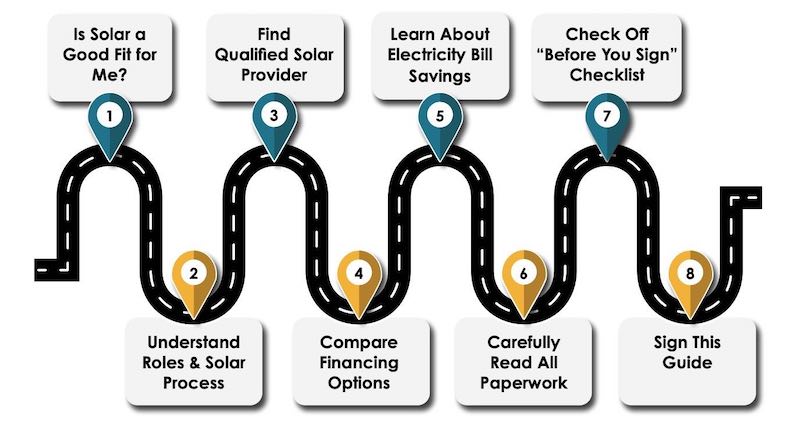Updated 11 months ago
What is California’s Solar Consumer Protection Guide?
Written by
Catherine Lane

Find out what solar panels cost in your area
California’s utility regulator has introduced a new guide to protect consumers from unscrupulous solar vendors. We explain what the guide says and how it will help California solar energy consumers.
California solar installers are required to provide customers with the California Public Utility Commission’s (CPUC) Solar Consumer Protection Guide; a 24-page document with essential information about solar installations.
The protection guide was set in motion by Decision (D.)18-09-044, a decision that requires the CPUC’s Energy Division to develop an information packet for solar energy customers. From there, the CPUC determined that the packet must be accessible to residents of all social and economic backgrounds who are interested in learning more about consumer solar power.
The guide’s ultimate goal is to help consumers make an informed decision when it comes to installing solar on their home.
What is included in California’s Solar Consumer Protection Guide?
It is now mandatory for homeowners going solar to sign the first four pages of California’s Solar Consumer Protection Guide if they are a customer of either Pacific Gas and Electric (PG&E), Southern California Edison (SCE) or San Diego Gas and Electric (SDG&E). Otherwise, your solar panel system cannot be connected to the grid.
Page 1 of CPUC’s Consumer Protection Guide
The first page informs residential solar energy consumers of what languages the guide is in: English, Spanish, Chinese, Korean, Vietnamese, and Tagalog. An audio version is also available on the CPUC website.
Page 2 of CPUC’s Consumer Protection Guide
The second page outlines common false claims you might hear from solar installers. For example, it warns customers about solar installers that claim you will have no electric bills after getting solar.
In fact, most electric bills have standard fees and service charges that are unable to be offset by your solar system. If you find that your solar installer doesn’t fully explain something like this, they might not be reputable.
Page 3 of CPUC’s Consumer Protection Guide
The third page outlines your rights as a solar customer. These rights include:
Having the right to a copy of a solar contract and a financing agreement. Both documents must be provided to you in the language in which the salesperson spoke to you;
Having the right to read the entire solar consumer protection guide before signing a contract;
Having the right to a Solar Disclosure Document, which shows the total costs for a solar panel system; and
Having the right to a 3-day cancellation period after a contract is signed. Different solar installers may have different cancellation terms, but they must provide you with a minimum of 3 days to cancel.
Page 4 of CPUC’s Consumer Protection Guide
The fourth page of the guide provides some basic (but important!) questions that everyone should ask a solar installer before signing a contract. Asking these questions can help you determine if the solar installer is right for you.
If you’re interested, we’ve written up a more detailed list: 8 questions to ask your installer before you go solar
The fourth page is the last that you are required to sign. The rest of the guide provides supplemental information that can help you understand the process of going solar.
There is information on low-income solar programs, financing options, and how to find a qualified solar installer. It also includes a final checklist to make sure you are making a well-informed decision.

Recommended steps to take when a homeowner is considering going solar. Image source: California Public Utilities Comission
What is the purpose of the CA consumer protection guide?
The CPUC aims for the guide to solve common problems solar customers have historically faced by providing information about solar installations directly to customers.
The CPUC determined that one of the biggest issues prospective solar energy customers encounter are aggressive and often misleading sales strategies used by solar installers. These strategies include:
Giving homeowners incomplete information regarding the benefits and the costs of solar; and
Providing misinformation about various incentives.
One of the sales tactics highlighted in the consumer protection guide included installers pressuring homeowners to sign a contract, sometimes on the very same day the installer met with the customer. This sales tactic does not give homeowners enough time to read through and consider a contract.
To address this, the guide suggests that homeowners take between 48 hours and one week to review all of the information, giving themselves time to become familiar with the contents.
Another concern of the CPUC was a possible language barrier for non-English speakers, especially those in low income areas. In order to combat this all-too-present problem, the consumer protection guide was made available in 6 languages, covering a large margin of non-English speaking individuals.
The guide is a good step to protect solar energy consumers
The solar consumer protection guide was designed with these issues in mind, in order to prevent these types of barriers from affecting customers and possibly preventing them from obtaining solar.
Hopefully, the guide can shed light on solar contracts and force solar installers to be more honest with their customers.
Editorial note: SolarReviews supports efforts to increase transparency between installers and customers and to keep consumers well-informed. This is a core reason why SolarReviews hosts honest customer reviews and does not let companies edit or remove them.
Catherine has been researching and reporting on the solar industry for five years and is the Written Content Manager at SolarReviews. She leads a dynamic team in producing informative and engaging content on residential solar to help homeowners make informed decisions about investing in solar panels. Catherine’s expertise has garnered attention from leading industry publications, with her work being featured in Solar Today Magazine and Solar ...
Learn more about Catherine Lane